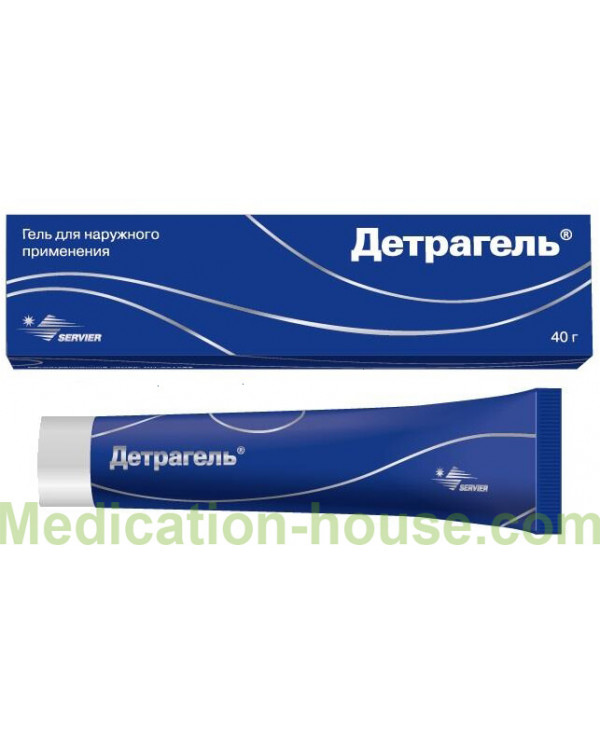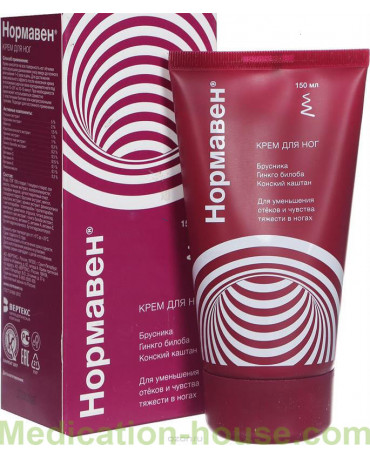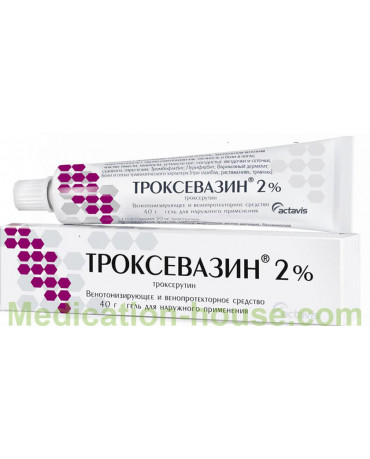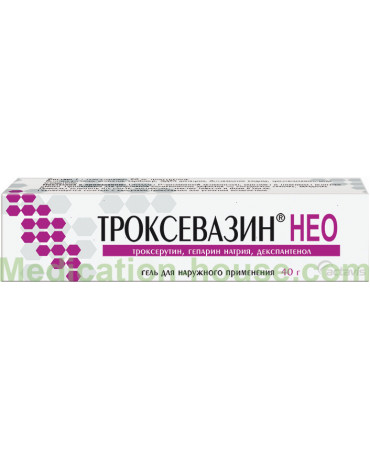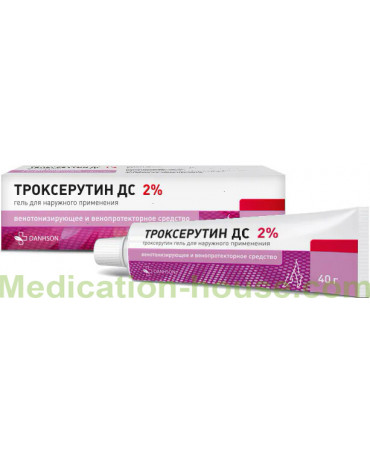Instruction for Detragel
Reed more and buy Detragel here
Composition
1 g of gel contains:
Active substance:
Sodium Heparin 100.0 ME, Essential Phospholipids 10.0 mg, Escin 10.0 mg
Excipients:
Isopropanol 300.00 mg, glycerol 85% 20.00 mg, trolamine 10.80 mg, methyl parahydroxybenzoate 0.75 mg, 2 ethyl parahydroxybenzoate 0.75 mg, propyl parahydroxybenzoate 0.25 mg, carbomer-980 8.00 mg, cologne 0.70 mg, rosemary oil 0.40 mg, lavender oil 0.40 mg, water up to 1.00 g.
Polishing adjuvant for tablets: macrogol 6000 1,300 mg. The mass of the tablet, film coated 1378,425 mg. [1]) Given the average moisture content of the purified, micronized flavonoid fraction — 4% (or 40 mg per tablet), the amount of the substance per tablet is 1040.00 mg.
Pharmacodynamics
Combined drug, has a local anticoagulant, anti-inflammatory, venotonic and antiplatelet effect, reduces the permeability of veins, improves microcirculation. Detragel contains 3 active substances sodium heparin, essential phospholipids and escin, which have pharmacodynamic and pharmacokinetic synergism. Heparin sodium - direct acting anticoagulant; due to the inactivation of biogenic amines and the blocking of lysosomal enzymes in the tissue, exhibits anti-inflammatory action, accelerates the dissolution of microthrombus in the area of the subcutaneous capillaries, prevents thrombosis, activates the fibrinolytic system; improves microcirculation, promotes the regeneration of connective tissue by inhibiting the activity of hyaluronidase. Essential phospholipids reduce blood viscosity due to the effect on fat metabolism, reduce platelet aggregation processes. Escin is a plant-derived venotonic agent. It prevents the activation of lysosomal enzymes that break down proteoglycan, increases the tone of the venous wall, eliminates venous stasis; reduces capillary permeability and fragility. It reduces exudation, reduces the effusion of fluid in the tissue and accelerates the resorption of existing edema. It inhibits inflammation, improves microcirculation, promotes tissue repair.
Pharmacokinetics
Information on the pharmacokinetics of escin and phospholipids for external use is not available. Heparin sodium, when applied topically, quickly penetrates the epidermis and accumulates in the upper layers of the skin. A small amount of heparin sodium is absorbed from the skin surface into the systemic circulation (less than 0.2% of the total amount applied). The maximum concentration (Cmax) in the blood is noted 8 hours after application. After absorption, it is biotransformed in the liver and in the reticuloendothelial system. Sodium heparin is mainly excreted in the urine. The half-life (T1 / 2) is 12 hours. Heparin does not penetrate the placental barrier and is not excreted in breast milk. Due to its own hydrophilic and lipophilic properties, essential phospholipids promote the rapid penetration of active ingredients through the sebaceous and sweat glands, which was confirmed by tests with radioisotopes.
Indications
Therapy for symptoms of chronic venous disease;
Varicose disease with symptoms in the form of pain, edema, heaviness and tiredness in the legs, night cramps of the calf muscles, and signs of telangiectasia (spider veins and spider veins) and varicose veins;
Superficial phlebitis, thrombophlebitis;
Hematomas in injuries, including sports stretching and bruises;
Postoperative hematomas without compromising the integrity of the skin.
Contraindications
Hypersensitivity to the components of Detragel, hemorrhagic diathesis (including thrombocytopenic purpura), hemophilia, violation of the integrity of the skin at the site of application of Detragel (open wounds, ulcero-necrotic lesions), burns, eczema, skin infections
It is contraindicated for use on mucous membranes.
Age up to 18 years
Pregnancy and lactation period
To date, there have been no reports of adverse effects on the mother and fetus when Detragel is used by pregnant women. Use during pregnancy and during breastfeeding is possible only in cases where the expected benefit of therapy for the mother outweighs the potential risk to the fetus, so you should consult with your doctor before using Detragel.
METHOD OF ADMINISTRATION AND DOSES
For external use. The gel is applied with a thin layer to the problem area of the skin and evenly distributed with light massaging movements: 2-3 times a day every day until the symptoms disappear. If necessary, the gel can be applied under elastic stockings or bandages. In case of thrombophlebitis, rubbing of the gel should be avoided. Application of the gel on the mucous membranes is contraindicated.
The duration of treatment is not more than 15 days. If your condition worsens or does not improve after 15 days, you should consult a doctor. The possibility of a longer course of treatment is determined by the doctor. Do not exceed the recommended dose and duration of use of Detragel.
Side effects of Detragel
Side effects are given in the form of the following gradation: very often (> 1/10); often (> 1/100, <1/10); infrequently (> 1/1 000 <1/100); rarely (> 1/10 000, <1/1 000); very rarely (<1/10 000), unspecified frequency (frequency cannot be calculated from available data).
From the skin:
Very rare: delayed-type allergic reactions (contact dermatitis)
Very rarely: immediate-type allergic reactions (skin rash, pruritus, urticaria)
On the part of the respiratory system, organs of the chest and mediastinum:
Very rare: bronchospasm. In the case of topical administration of escin, isolated cases of the development of acute anaphylactic reactions have been reported (see section “Special Instructions”).
INFORM THE DOCTOR ABOUT THE APPEARANCE OF ANYONE IN YOUR ANSWERE, INCLUDING THE NUMBER NOT MENTIONED IN THIS INSTRUCTION, UNDESIRABLE REACTIONS AND SENSATIONS, AND ALSO, ABOUT CHANGES IN THE LABORATORY INDICATORS OF THE PHONESTER.
Overdose
Data overdose of Detragel is not available. In case of overdose, you should immediately consult a doctor. Treatment: in case of overdose, the action of heparin can be neutralized with a solution of protamine sulfate.
Interaction with other drugs
There are currently no data on interactions with other drugs. Detragel should not be applied to the same area of the skin simultaneously with other drugs for external use.
IT IS NECESSARY TO INFORM THE MEDICAL DOCTOR ABOUT ALL YOU TAKE MEDICAL PREPARATIONS.
SPECIAL INSTRUCTIONS
Putting gel on mucous membranes is contraindicated.
In the case of allergic reactions, use of Detragel should be immediately stopped and consult a doctor.
Drugs for topical use, especially after prolonged use, have a sensitizing effect. If this occurs, the drug treatment should be discontinued and, if necessary, appropriate treatment is prescribed.
With prolonged use of Detragel on large areas of skin and simultaneous use of indirect anticoagulants (warfarin, acenocoumarol, etc.), the prothrombin time and blood clotting time should be monitored.
Detragel is not recommended for use in deep vein thrombosis.
Experience with the use of the drug in children under 18 years old is missing.
If your condition worsens or does not improve after 15 days, you should consult a doctor.
Influence on the ability to drive vehicles, mechanisms: Studies on the effect of Detragel on the ability to drive a car and control the mechanisms have not been conducted.
Release form
Gel for external use. On 40,0 g in a tuba aluminum, closed by a membrane and the screwed cover made of polypropylene. A tube with instructions for use is placed in a cardboard box
Storage
At a temperature not higher than 25 ° С. Keep out of the reach of children.
Shelf life - 2 years. Do not use after the expiration date printed on the package.
Terms of sell
You don't need a prescription to buy Detragel.

